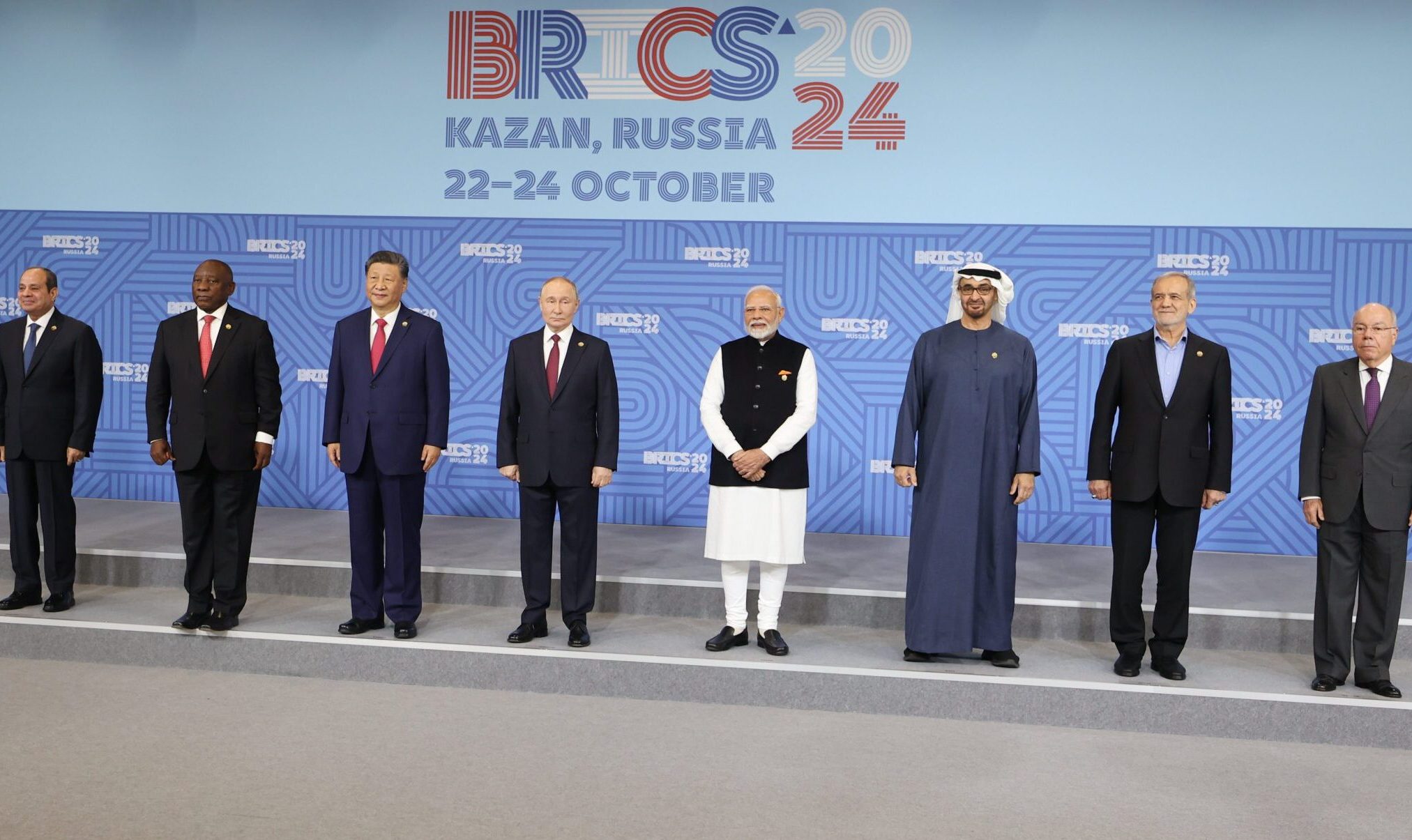
BRICS+ Summit: Independent Payment System
The recent BRICS+ summit, as highlighted by the Kazan Declaration, has marked what the Kremlin hoped would be a pivotal moment in the trajectory of the global financial order. This declaration, reflecting the allegedly unified determination of what is increasingly viewed as an anti-Western coalition, has set the stage for the proposal of a more self-reliant financial framework, independent of US-dominated systems.
Spanning 132 provisions, at the heart of this endeavor is the BRICS+ Cross-Border Payment Initiative (BCBPI), a strategic response to the perceived illegitimacy of sanctions imposed by Western nations. By “strengthening the correspondent banking networks within BRICS+ and enabling settlements in local currencies,” the initiative seeks to reduce the risks associated with dependence on the US currency. The initiative, however, is not merely a defensive measure; it represents a deliberate attempt to push the Moscow-led agenda of de-dollarization, ostensibly supported by Beijing despite the rigid nature of Chinese capital controls.
Strategy aside, at the granular level, three key components underpin the BRICS+ vision: BRICS Pay, BRICS Bridge, and BRICS Clear. BRICS Pay reportedly aims to interconnect domestic payment systems across member nations, although it remains more symbolic than operational given the current lack of a live system. Conversely, BRICS Bridge, inspired by the Bank for International Settlement’s project ‘mBridge’, leverages Distributed Ledger Technology (DLT) to facilitate local currency transactions through the likely incorporation of multi-central bank digital currencies (CBDCs), functioning as a backend payment infrastructure. Against this backdrop, BRICS Clear proposes a securities depository and settlement system as an alternative to Western entities such as DTCC and Euroclear, which is currently under study.
Sino-Russian Economic and Financial Cooperation
Integral to the BRICS+ grand plans are the burgeoning economic ties between China and Russia. Catalyzed by the incursion into Ukraine, these ties have served as a significant testing ground, effectively laying the foundations for the BRICS+ initiative to establish a self-reliant financial framework. This period has seen a marked increase in bilateral activities, driven by the Kremlin’s objective of lessening the impact of Western sanctions, whilst China has opportunistically benefited from the enhanced economic and trade links. However, despite the expanded collaboration, this relationship has proven fraught with challenges and poses considerable risks to the Russian economy, most notably when it comes to trade imbalances and an excessive reliance on China.
The elevated levels of cooperation were characterized by several noteworthy developments; most prominent being the bilateral trade and currency swap agreements allowing trade to be conducted in national currencies. Remarkably, transactions in national currencies increased by 67% in 2022 compared to the previous year, and by the end of 2023, 95% of Sino-Russian trade was conducted in these currencies. This was largely facilitated by streamlining their alternative payment systems, through the improved integration of Russia’s System for Transfer of Financial Messages (SPFS) with China’s Cross-Border Interbank Payment System (CIPS), with a view to bypass the SWIFT system, and thereby enhance the financial stability and operational continuity of firms subjected to the rafts of Western sanctions.
Further amalgamation of payment systems was achieved through the integration of Russia’s Mirnetwork with Chinese UnionPay. Mir was initially conceived as a central bank-owned card network in response to Western demands for Russia’s exclusion from SWIFT, following the annexation of Crimea in 2014. This strategic development allowed Russia to cushion the impact of the extensive Western sanctions imposed in 2022. Their integration allowed for rapid and secure transactions, expanded payment options, reduced costs, and mitigated currency risks. Yet, regardless of these developments, the financial cooperation mechanisms between China and Russia remain markedly underdeveloped when juxtaposed with their international counterparts. The current state of play is largely defined by a lack of market risk mitigation tools, regulatory mechanisms, and insufficient information exchange, whilst the efficiency of payment and settlement channels is often patchy.
Feasibility of the BRICS+ Payment System
Amidst these conditions, the payment system outlined in the Kazan Declaration, centered on leveraging digital currencies issued by central banks to eliminate the need for correspondent banks, presents an ambitious yet fraught initiative. Ignoring global market demand for the dollar, the concept of decentralizing US control over international payment presents clear benefits to the interested parties, although the feasibility of this system remains highly questionable. Prospects for global diversification towards BRICS+ currencies remain very unlikely. With current levels of economic integration among BRICS+ countries minimal at best, direct competition between these economies could severely impede the smooth implementation of the payment system.
This is further exacerbated by the diverse nature and stages of economic development, alongside varying regulatory frameworks that characterize the respective BRICS+ nations, adding substantial complexity to launching the project. Whilst the initiative evidently draws on the accomplishments of the mBridge project, this source of inspiration also offers a cautionary tale. In light of the technical successes of mBridge in a 2022 trial that demonstrated the potential for digital currencies in cross-border payments, they also underscored the necessity of traditional markets due to the credit and liquidity risks encountered, as well as a lack of alignment in overall standards.
These challenges are further compounded by the adverse effects that could impact the bloc, including imbalanced trade and capital flows, with the potential to aggravate economic inequalities among BRICS+ nations. Perhaps most importantly, the concept of relying on political means to drive economic realities is inherently problematic. The extension of central bank – and therefore political – authority over the market mechanism would inevitably fuel conflicts of interest, reduce the efficiency of monetary policy, inhibit capital markets and, rather paradoxically, stifle innovation within the banking sector – all to the detriment of the domestic economy. These various setbacks remain a key issue faced by participant countries, materialized through their collective need to agree on governance transparency, reporting, and regulatory mechanisms, piling on the layers of complexity to the proposal. Yet, if these significant challenges were overcome, the payment system could herald a new era of international financial decoupling that could blur the contours of the global economic order.
Implications for the West
The BRICS+ initiative carries extensive implications for Western countries across geopolitical, economic and financial vectors; nonetheless it is crucial to approach this development with a degree of skepticism. After all, despite the ambitions to reshape the international banking system, the US dollar continues to dominate global financial transactions.
Moreover, the substantial gaps in the development of financial infrastructure among BRICS+ countries will undoubtedly act as a perennial problem for the framework in terms of its implementation. Given that the digital architecture and coding driving the initiative are disproportionately produced within China, the disparity amongst the member states highlights the uneven playing field within the BRICS+ bloc, raising questions regarding the practicality of a unified payment system. Finally, from a strategic perspective, the project appears to be fundamentally at odds with China’s attempts to grapple with the arduous task of increasing renminbi market share whilst maintaining strict capital controls, suggesting that the initiative may be predominantly driven by Russian diversification interests rather than a collective BRICS+ agenda. Tellingly, whilst the Chinese Ministry of Foreign Affairs has offered comparatively muted expressions of general support for reforming the international financial architecture, it is the Russian state media that has been the clear and vocal proponent of this initiative.
Written by
David Corbett
David Corbett is a co-director of the YCW London chapter and a financial services professional, operating in the banking and capital markets sector. He holds degrees in economics and foreign languages (Chinese and Russian) from the University of Edinburgh and the School of Oriental and African Studies (SOAS). A former trade policy analyst, he has experience of working on Greater China and Asia-Pacific markets within the UK government. His research interests are centered on Chinese economic development, sustainable structural transformation, and Chinese influence across the post-Soviet space and Western Balkans.


